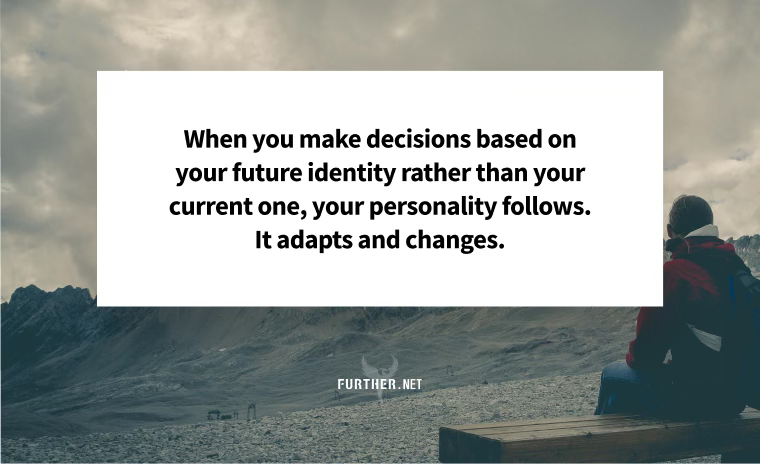|
What's Fixed and What's Flexible: The Architecture of Your Midlife Story
This second article in the Midlife Identity Remix series will help you understand yourself in a new way. And that will clear the path toward meaningful change.
Are you excited about changing your story at midlife?
Hopefully so. But you also may be thinking about the last time you tried to make a significant change. And you’re remembering that it felt difficult, bordering on impossible.
Like pushing against a wall.
Like trying to become someone you fundamentally aren’t.
Like your brain screaming, “This isn’t who we are. Stop.”
That feeling isn’t a weakness, and it’s not a lack of willpower. It’s your brain protecting an identity it thinks is you.
But here’s the good news: Most of what feels unchangeable actually isn’t. You just need to understand what’s flexible about your personality and how to shift it in a new direction.
This second article in the Midlife Identity Remix series will help you understand yourself in a new way. And that will clear the path toward meaningful change.
If you missed last week’s series introduction, go ahead and read it first: Midlife Isn’t a Crisis, It’s a Plot Twist.
Your Personality Is More Flexible Than You Think
Most people believe personality is fixed. Unchangeable. “Just who I am.”
The research tells a different story.
Dr. Brian Little, a personality psychologist whose work spans decades, found that only about one-third of personality is genetic. That means two-thirds is shaped by experience, environment, and intentional development.
That’s a lot of room for change.
Dr. Benjamin Hardy, in his book Personality Isn’t Permanent, puts it this way:
Your personality will adapt to the level of your goals and decisions, rather than your decisions and goals falling to the level of your current personality.
When you make decisions based on your future identity rather than your current one, your personality follows. It adapts and changes.
You’re not stuck. But you need to understand what you’re working with.
Your Three-Layer Personality Architecture
Dr. Little identifies three sources of personality. Think of them as three layers that make you who you are.
1. Biogenic Traits (The Genetic Baseline)
This is the one-third that’s hardwired. They’re your baseline dispositional tendencies:
Where you fall on the introversion/extroversion spectrum
Your sensitivity to stimulation
Risk tolerance versus cautiousness
Emotional reactivity
This is the hardware. You can’t change it, and you shouldn’t try to. Instead of working against it, you work with it to achieve the ideal alignment.
For example, if you’re dispositionally introverted, you’re not going to become extroverted.
But you can build a life and career that works with introversion instead of fighting it (just like I did). And I can tell you from experience that you can develop the ability to perform extroverted behaviors when it serves your goals.
2. Sociogenic Traits (Cultural Programming)
Sociogenic traits are absorbed from your family, your culture, your social groups, and your generational cohort. They feel like “who you are,” but they were actually installed by your environment.
This is where the committee’s deepest influence lives. Examples:
“People like us don’t make scenes.”
“In our family, we value stability over adventure.”
Gender role expectations you absorbed growing up.
Class-based assumptions about what’s appropriate.
Gen X-specific traits: self-reliance, skepticism of institutions, ironic distance.
Here’s the key insight: Sociogenic traits feel as fixed as biogenic traits. But they’re not.
They are learned. Which means they can be unlearned.
These traits are sticky because they’re constantly reinforced by your social context:
Your family still expects you to be “the responsible one.”
Your old friends still see you as “the scattered one” or “the serious one.”
The culture you grew up in still broadcasts its values.
But sticky doesn’t mean permanent. And one of the fastest ways to see your sociogenic programming is to remove yourself from the culture that installed it.
This is why travel and exposure to other countries’ customs can be so transformative at midlife. When you spend time in a different nation, you suddenly see that “People like us don’t...” was never a universal truth. It was just one culture’s programming.
The French approach to work-life balance makes you question American hustle culture.
The Latin American attitude about meals and relationships challenges your beliefs about productivity.
The expat life reveals how arbitrary so many of your “supposed to’s” actually were.
Distance creates perspective. And perspective creates choice.
This is one reason location independence isn’t just about your ideal business or lifestyle design. It’s also about identity freedom. When you’re not constantly swimming in the water that programmed you, you can finally see the water itself.
3. Idiogenic Traits (Self-Authored)
This is what you consciously choose to do and be. Your agency. Your authorship.
Dr. Little refers to putting these “free” traits to work as your personal projects. They’re the meaningful goals and pursuits you choose to commit to, not just tasks on a to-do list. They’re the projects that matter to you and give your life meaning and direction.
Free traits are where change happens most readily, because you’re making intentional decisions about who you want to become and what you want to build.
It’s a personal project when:
You consciously decide, “I’m becoming someone who builds an expertise-based business.”
You choose to develop a skill that doesn’t come naturally because it serves your goals (say, speaking in front of crowds).
You commit to writing, exercising, or working on your personal development.
Personal projects are powerful because they give you the sense of purpose to use your free traits in the first place. They’re what mak
